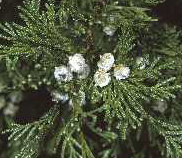 |
On-line Proceedings of the
2009 Atlantic White-Cedar Symposium
The Ecology and Management of
Atlantic White-Cedar (Chamaecyparis thyoides) Ecosystems
A Symposium held on June 9, 10, and 11, 2009 at the
City Hotel and Bistro in Greenville, North Carolina - USA |
Relationships of Atlantic White-Cedar with Precipitation, Temperature, and Drought Intensity Assessed through Tree Ring Analysis
Catey Lavagnino, Craig Patterson, and Robert B. Atkinson, Christopher Newport University, Center for Wetland Conservation
Presented by Catey Lavagnino
Ditching, over-harvesting, and other anthropomorphic influences have adversely affected Atlantic white-cedar swamps, a globally-threatened ecosystem. The evergreen conifer, Chamaecyparis thyoides (cedar), is highly sensitive to water table conditions and becomes stressed under drought or flooding events. Ditches in the Great Dismal Swamp National Wildlife Refuge (GDSNWR) in Virginia and North Carolina have altered the water table and represent a challenge to selecting water table targets for restoration. This study aimed to better understand chronology of cedar stands and the relationship between climate and radial growth of cedar. Tree cookies were obtained from ten salvage-logged cedar stands in the GDSNWR and compared with Lake Drummond water levels as well as regional precipitation, temperature, and drought intensity (Palmer Drought Severity Index, PDSI) over a 20-month period to evaluate both preceding and current growing season correlations (p < 0.05). PDSI was the strongest predictor of ring width for both growing seasons of the 20-month model. In the preceding growing season, there were 7 consecutive months (May through November) of significant negative relationships of precipitation and ring width; and, in the current growing season, there were 6 consecutive months of significant positive relationships (June through November). Additional significant relationships were apparent between tree ring width and water levels, drought levels, and precipitation, but there was no significant relationship between ring width and temperature. Through an improved understanding of the historical climate and stressors of the cedar stands, the conservation efforts of these species may be enhanced.
- Slides (will open in new window)
- Notes (will open in new window)
Proceedings Table of Contents and Conference Links
